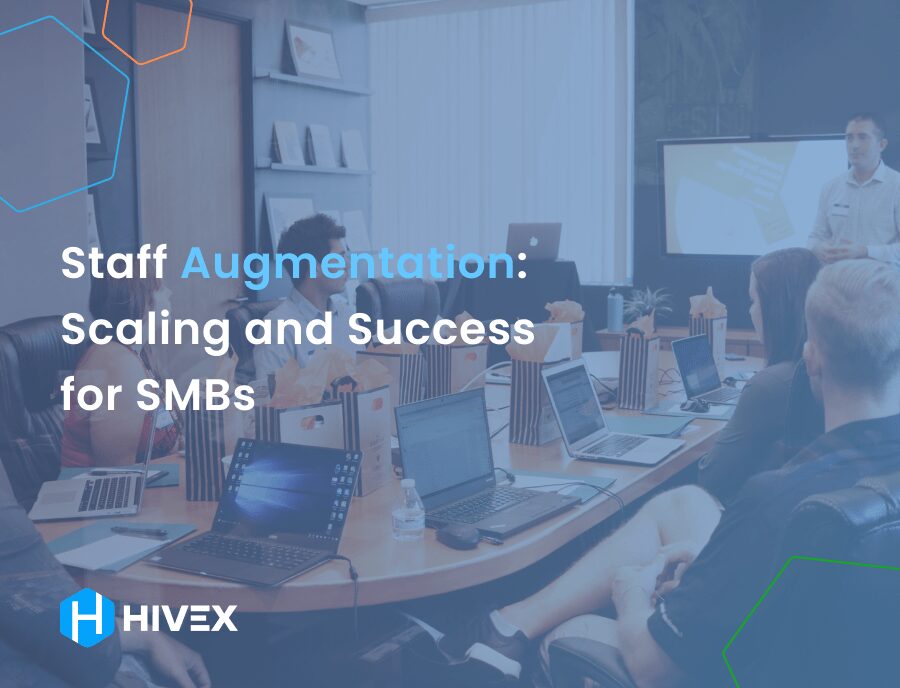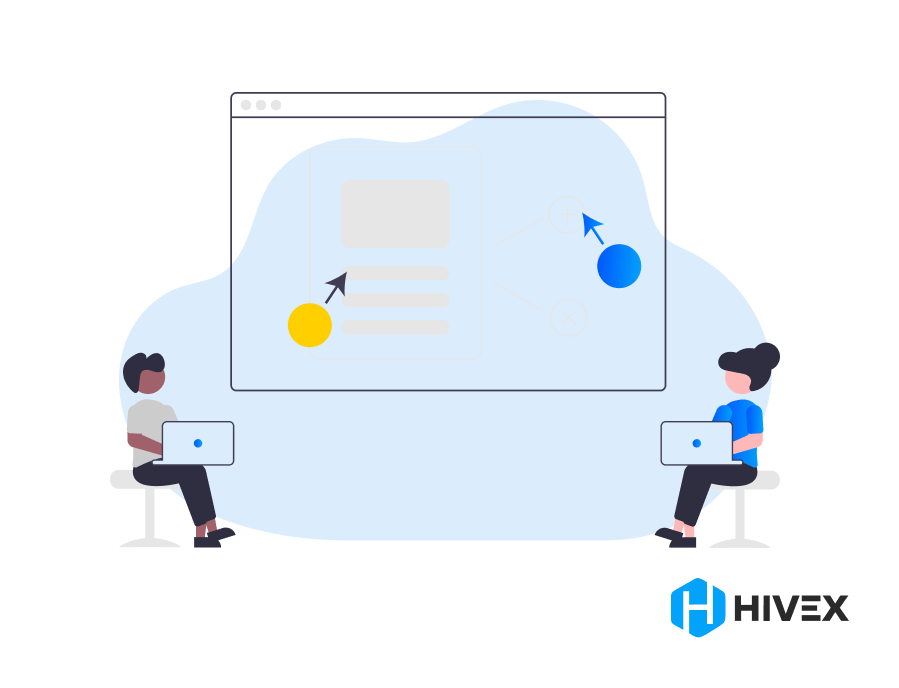Staff Augmentation: Scaling and Success for SMBs

With new technologies popping up daily and customer expectations skyrocketing, small and medium-sized businesses are constantly challenged. Limited budgets, a shortage of skilled personnel, and the need for quick turnaround times can pose significant obstacles. However, there is a solution that can help SMBs overcome these hurdles – software development staff augmentation.
What is Staff Augmentation?
Staff augmentation refers to the practice of augmenting a company’s existing workforce by hiring external specialized resources who work directly under the supervision and guidance of the company’s management.
By supplementing the organization’s staff with external professionals, businesses can tap into a broader talent pool, bringing in fresh perspectives, innovative ideas, and advanced skill sets that may not be available internally.
This collaborative approach fosters knowledge sharing and facilitates the transfer of specialized expertise to the existing staff, contributing to the overall growth and development of the organization.
Staff augmentation enables you to access niche talent, bridge skill gaps, and scale up the workforce as needed, without the long-term commitments and costs associated with hiring full-time employees.
Staff Augmentation in Software Development
Software development services and projects often require specialized expertise that may not be available in-house. This is where staff augmentation comes in, enabling businesses to quickly and efficiently fill that expertise gap by hiring skilled developers on a temporary basis.
There are several types of staff augmentation services, including team augmentation, project-based augmentation, and skill-based augmentation.
With team augmentation, businesses expand their teams with remote specialists who possess specific skills required for the project.
With project-based augmentation, companies access an entire team of tech talent for the duration of their project, from project managers to frontend and backend developers, DevOps engineers, and testers.
Skill-based staff augmentation, on the other hand, enables businesses to address specific project goals by hiring a specialist with a particular skill set or expertise.
The advantages include the speed of hiring, flexibility in scaling up or down resources, and access to a global talent pool.
It also allows businesses to utilize their existing in-house resources more efficiently, reduce recruitment and training costs, and address project requirements quickly with specialized talent.
Staff augmentation companies have a significant role to play in providing the necessary talent, as they can fill gaps in a company’s tech team by sourcing, vetting, and hiring the right talent.
Why Staff Augmentation Works for SMBs

Staff augmentation is a practical and advantageous solution for SMBs facing scaling challenges. By partnering with a staff augmentation provider, they can access a pool of skilled professionals temporarily, overcoming resource constraints and talent shortages. This allows SMBs to scale up their operations efficiently and tap into specialized expertise as needed, enhancing productivity and project outcomes.
Moreover, staff augmentation offers cost-effective workforce solutions. Instead of hiring full-time employees, companies can engage temporary workers with particular skills, saving on recruitment, training, and employee benefits costs. This enables SMBs to better manage their project costs and allocate their financial resources more efficiently.
Staff augmentation provides a flexible and scalable staffing model that aligns with SMB needs. It enables businesses to easily adapt to fluctuating project requirements, adding or reducing resources as required.
By leveraging staff augmentation talent, SMBs can overcome workforce challenges, optimize resource utilization, and achieve success in scaling up their operations. It empowers them to compete effectively, deliver high-quality projects, and drive business growth.
The Benefits of Staff Augmentation for Software Development

Team augmentation offers numerous benefits to businesses needing expertise for software engineering projects. By partnering with a skilled staffing company, businesses can access a global pool of talent and benefit from specialized technical knowledge and skills.
1. Utilizing Existing Resources More Efficiently
Staff augmentation allows businesses to optimize their resources by leveraging their existing teams and infrastructure. Instead of hiring full-time employees for specific projects, businesses can augment their teams in place with managed services to complete projects efficiently. This approach saves time and reduces overhead costs.
2. Tapping into Specialized Technical Expertise
Partnering with a skill-based staffing firm gives businesses access to a wider pool of specialized talent. This approach allows businesses to take on complex and specialized projects, and secure the necessary skillsets and technical proficiency to complete them. By accessing a diverse candidate pool, businesses can meet project goals and keep up with technological changes.
3. Effective and Efficient Project Management
Staff augmentation partners offer businesses a range of project management and support services. These include providing the necessary hardware, software, and workspace for team members.
As a result, businesses can focus on their core projects without worrying about supporting infrastructure. Additionally, skilled managed service contractors can help businesses meet project deadlines more effectively by coordinating tasks among team members, ensuring timely delivery of projects, and helping to resolve any technical issues.
In summary, team augmentation offers businesses a bunch of benefits. By partnering with a skilled staff augmentation provider, businesses can access a global pool of talent, utilize their resources more efficiently, and access specialized technical skillset.
Effective project coordination and support services provide businesses with the necessary infrastructure to succeed in today’s highly competitive and rapidly changing technological environment.
The Most Common Staff Augmentation Services
When companies choose to rely on staff augmentation services, there are a few key areas where extra support is most needed. The most in-demand offerings typically fall into categories like IT and software development, creative services, design, and administrative.
The most common staff augmentation services cover the following areas:
- Development: Augmented tech talent works alongside in-house software developers and is responsible for the implementation of software features. They ensure adherence to coding standards and best practices, collaborating closely with the IT team to deliver high-quality code.
- Quality Assurance: Augmented testers play a vital role in ensuring the quality and reliability of the software being developed. They perform rigorous testing to identify bugs, conduct test case analyses, and provide valuable feedback to the team leaders. Their expertise helps in delivering a robust and error-free software solution that boosts the efficiency of the entire project.
- Design: Augmented designers bring their creative skills to the project, collaborating with the internal team to create intuitive user interfaces and engaging user experiences. They work closely with the development team to understand the particular project requirements and translate them into visually appealing designs that enhance the overall user experience.
- Project Management: The outsourcing team can also take on project management roles, ensuring software engineering projects are executed smoothly and efficiently. They oversee the project timeline, manage resources, and communicate with stakeholders to meet project demands.
- Technical Support: Augmented staff can provide technical support during the coding process. They can help troubleshoot issues, guide best practices, and offer solutions to technical challenges during the development lifecycle.

Choosing the Right Staff Augmentation Model
When it comes to software development resources, team augmentation offers a flexible solution for SMBs. However, it is crucial to choose the right model that fits their specific needs. Let’s explore the factors to consider and the different types of staff augmentation models available.
Factors to Consider When Choosing a Staff Augmentation Model
When selecting a staff augmentation model, SMBs should take into account the following factors:
- Project Complexity: The complexity of the software engineering project plays a significant role in determining the staff augmentation model. Complex projects may require extended collaboration or dedicated resources.
For example, suppose the project involves intricate algorithms or cutting-edge technologies. The project will be executed efficiently and with the highest technical proficiency if you utilize an approach that provides access to specialized software developers with relevant expertise. - Duration: For short-term projects with specific deliverables, a temporary staff augmentation model may be more suitable. On the other hand, long-term projects that require ongoing development and maintenance may benefit from a more extended partnership with augmented staff.
When a company plans to develop a complex enterprise software solution that will require continuous updates and enhancements, a long-term staff augmentation model can provide the necessary resources. - Team Integration: Consideration should be given to how the augmented team will integrate and collaborate with the existing one. Team dynamics and communication channels are vital for seamless project execution.
When integrating an external IT workforce into an existing dedicated team, it is essential to ensure effective communication and collaboration. This can be achieved through regular team meetings, clear project goals and expectations, and the use of collaboration tools and platforms.

Different Types of Staff Augmentation Models
Several different staff augmentation models exist, each with its strengths and considerations:
- Onshore Staff Augmentation: In this model, the outsourced team is located within the same geographical region as the business. This allows for easier communication, closer collaboration, and minimal timezone differences.
It provides better alignment and coordination among the external and internal teams for projects requiring frequent face-to-face interaction and real-time collaboration. - Nearshore Staff Augmentation: In nearshore staff augmentation, the external dedicated team is located in neighboring countries or regions with a similar timezone and cultural compatibility. This model offers cost-effectiveness while maintaining proximity for effective collaboration.
Using nearshore outsourcing allows companies to leverage talent pools in nearby regions and reduce costs, as opposed to onshore resources. Because of minimal timezone differences, effective communication and collaboration are still maintained. - Offshore Staff Augmentation: Offshore staff augmentation involves hiring resources from different geographical regions, often with significant timezone differences. While it offers cost advantages, offshore teams may face challenges related to communication and coordination.
This model reduces costs while retaining quality. To overcome potential language barriers and time zone differences, careful planning is required. To mitigate these challenges, establish clear communication channels and implement project management tools. - Remote Staff Augmentation: Here, external employees work from different locations, providing flexibility and access to a global talent pool. Effective communication and project management tools are crucial for this model’s success.
Implementing Staff Augmentation in Your Business
Implementing staff augmentation in your business requires careful planning and execution. Let’s explore the steps to implement staff augmentation and how to overcome potential challenges along the way.

Steps to Implement Staff Augmentation
When implementing staff augmentation, follow these steps:
- Define Project Requirements: Clearly define the skills, expertise, and duration of resources needed for your software development project.
- Identify Reliable Staff Augmentation Providers: Research and select reputable staff augmentation providers who have a track record of delivering high-quality resources.
- Scout and Select Resources: Collaborate with the staff augmentation company to identify and select the most suitable resources for your project.
- Onboard and Integrate: Seamless onboarding and integration of the augmented team with your existing one are crucial for effective collaboration and the project’s success.
- Communication and Project Management: Establish effective communication channels and utilize project management tools to ensure transparent and efficient project execution.
Overcoming Challenges in Staff Augmentation Implementation
While employee augmentation offers numerous benefits, some challenges may arise during implementation.
Here are some strategies to overcome these challenges:
- Clear Expectations: Clearly communicate project goals, expectations, and timelines to the augmented team to avoid misunderstandings or misalignments.
- Regular Communication: Foster open and frequent communication between the in-house team and augmented staff to ensure effective collaboration and address any issues promptly.
- Established Processes: Define clear processes and workflows to ensure consistency and streamline the integration of the augmented team with yours.
- Continuous Feedback: Provide regular feedback to the augmented staff to enhance their understanding of project requirements and improve their contributions.
Measuring the Success of An External Team
Measuring the success of an outsourced IT workforce is essential to ensure that expected benefits are realized.

When assessing the success of a staff augmentation project, consider the following KPIs:
- Time-to-Market: Measure the reduction in development cycles and the ability to meet project deadlines promptly.
- Product Quality: Assess the impact of an augmented team on software quality, including bug reduction rates and overall customer satisfaction.
- Cost Savings: Measure the cost savings achieved through staff augmentation, comparing them to traditional hiring models.
- Team Collaboration: Evaluate the seamless collaboration and integration between augmented employees and the existing in-house team.
Staff Augmentation vs In-House Team
When it comes to software engineering, businesses have two primary options: staff augmentation or building an in-house development team. Both approaches have their benefits and challenges, and it’s crucial to understand them before deciding. Let’s go through them.
Benefits of an In-House Software Development Team
Building an in-house team aligns the development process closely with business objectives and core values. It allows for more effective communication, as the team is physically located in the same office, promoting teamwork and collaboration.
Additionally, hiring employees in-house can be more cost-effective in the long run, as the company does not need to pay the markup for engaging a staffing agency or a managed service contractor.
Challenges of an In-House Software Development Team
Building an in-house team requires significant investment in recruitment, training, and development. This investment may not be feasible for SMBs.
Additionally, developing a technical culture in the business may take significant time and effort and require extensive training and team-building activities. Lastly, staff turnover can be an issue, as it is challenging to retain top talent for long periods.
Overall, building an in-house software development team is an attractive option for large businesses with significant resources. However, it may not be feasible for smaller businesses with limited budgets and an existing team with a different skill set.

Benefits of An Outsourced Software Engineering Team
Staff augmentation resources are cost-effective for SMBs because they don’t have to pay recruitment fees, onboarding expenses, or long-term commitments. By reducing costs, SMBs can allocate their budgets more efficiently and invest in other critical areas.
External staffing allows SMBs to access highly qualified professionals with specialized knowledge and perspectives needed for their projects.
When meeting tight deadlines or handling changes in scope, SMBs can scale their workforce accordingly. Because of this flexibility, SMBs can take advantage of new opportunities without being confined by a fixed workforce.
Staff Augmentation fosters knowledge transfer between internal and external teams, resulting in skill enhancement and higher-quality work.
Common Challenges of Staff Augmentation and In-House Development
One primary challenge of staff augmentation is integrating the augmented team with the existing team effectively. This process requires clear communication and defined work processes to avoid conflicts and duplication of efforts.
Additionally, businesses must carefully manage project requirements, ensuring that the external team aligns with ongoing projects without disrupting project timelines or risking project failure.
A similar challenge exists for building a team of internal developers. While having an in-house team may seem convenient, project goals can be complicated to manage.
Project management for an in-house team can be complex, considering the diversity of skills required for different projects. Coordination among team members and adherence to project timelines are essential to ensure successful project completion.
Comparing Cost and Efficiency
When considering the cost and efficiency of software development, businesses must weigh the benefits and drawbacks of staff augmentation and building an in-house development team.
Staff augmentation offers access to a global talent pool of specialized technical expertise at an affordable rate.
In contrast, in-house development teams may enjoy better communication but require higher costs, including salaries, benefits, and office space maintenance.
| Factors | Staff Augmentation | In-House Development |
|---|---|---|
| Initial Investment | Lower initial investment | Higher initial investment |
| Operating Costs | Lower operating costs | Higher operating costs |
| Health Insurance and Benefits | Not provided by a staffing agency | Provided for full-time employees |
| Efficiency of Talent Acquisition | Quick and efficient | Shorter time to hire but may require more effort |
| Project Management | Managed by a staffing agency | Managed in-house |
While staff augmentation may be more cost-effective, in-house development offers greater control over the development process and employees.

Selecting the Right Approach for Your Business
Choosing between staff augmentation and internal development can be a difficult decision for businesses. The right approach will depend on various factors, such as project requirements, timelines, budgets, and the availability of internal resources.
Here are some key points to consider when selecting the most suitable approach for your software development needs:
- Evaluate your internal resources: Determine whether you have the necessary internal resources to handle the project demands and whether the project requires a full-time or part-time team.
- Define your budget: Allocate a realistic budget for your software development project. Consider the costs of hiring and managing a team, providing medical insurance, and maintaining office space.
- Look for the right staff augmentation partner: Choose a reputable staff augmentation firm that offers flexible models, tech expertise, and a pool of talent suited to the project’s demands.
- Consider in-house team expansion: If you have existing in-house teams, evaluate whether expanding them would be a better approach than hiring external resources.
- Explore outsourcing vendors: If your project requires a niche technical skillset or specific tools, it may be better to find an outsourcing company that specializes in that area.
Ultimately, the success of your software development project will hinge on selecting the right approach for your specific needs. Consider each option carefully before making a decision.

Conclusion
In conclusion, businesses have two main options: hiring an external team or building an internal one. Both approaches have their benefits and challenges that vary based on demands, timelines, budgets, and internal resources availability.
Staff augmentation provides businesses with access to a global pool of talent, efficient utilization of existing resources, and specialized expertise. Building an in-house team provides full control over the development process and can result in a more integrated team, but it requires a significant investment in time, resources, and management.
Outsourcing project development to a third-party vendor is also a viable option for businesses needing cost-effective and efficient solutions. A solid staff augmentation company can be a valuable outsourcing vendor, offering businesses the flexibility to scale up or down their team as project requirements change.
Overall, businesses must consider project-specific needs and available resources before selecting an approach. By partnering with the right staff augmentation provider or expanding their internal team with the right talent, SMBs can optimize their development processes and achieve successful project outsourcing without compromising on quality.


